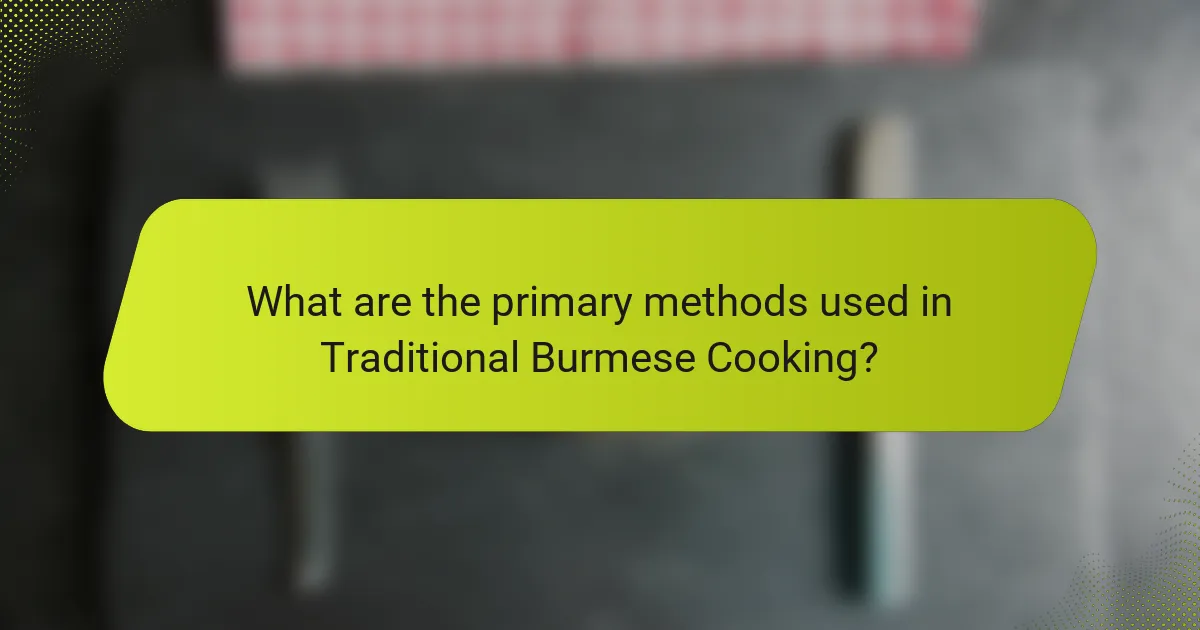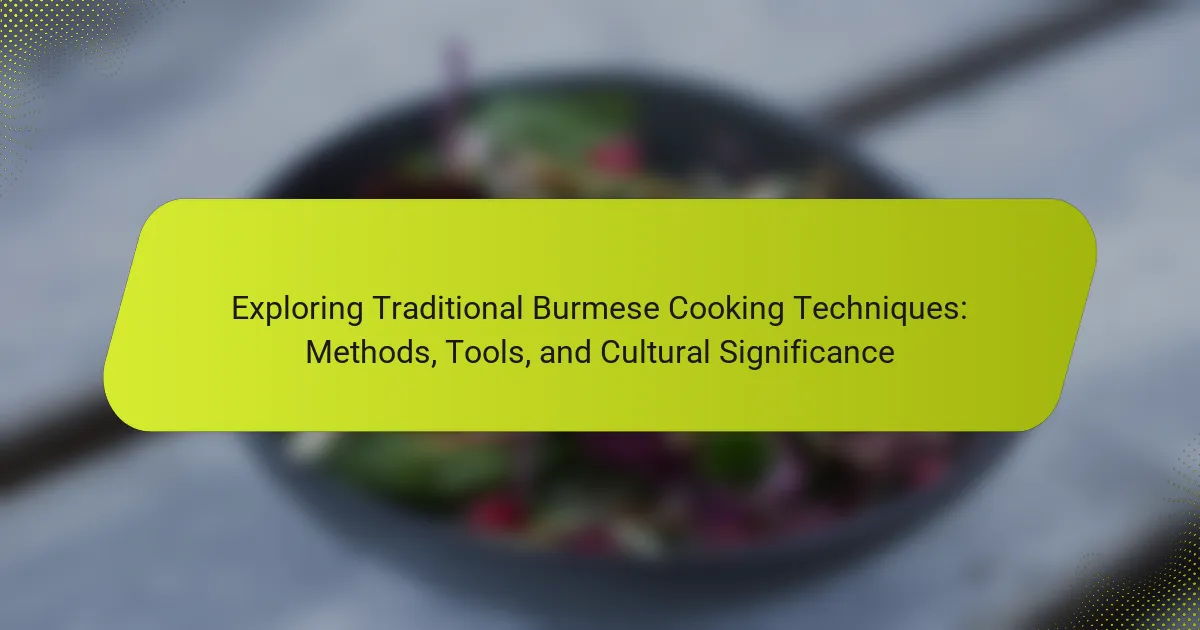Traditional Burmese cooking encompasses various techniques, including steaming, boiling, frying, and fermenting, which are integral to the cuisine’s unique flavors and textures. Key dishes such as mohinga, a fish noodle soup, highlight the importance of steaming, while boiling is essential for creating rich broths. Frying enhances the taste and texture of snacks, and fermentation is crucial for producing ngapi, a fermented fish paste. Essential tools like mortar and pestle, woks, and bamboo steamers facilitate these cooking methods, reflecting the cultural significance and agricultural practices of Myanmar. Understanding key ingredients and traditional preparation methods is vital for mastering this culinary heritage.

What are Traditional Burmese Cooking Techniques?
Traditional Burmese cooking techniques include steaming, frying, boiling, and fermenting. Steaming is commonly used for dishes like mohinga and rice cakes. Frying is prevalent for snacks and side dishes, such as fritters. Boiling is essential for soups and broths, allowing flavors to meld. Fermenting is a vital technique for producing ingredients like ngapi, a fermented fish paste. These methods reflect the country’s agricultural practices and local ingredients. Traditional cooking often utilizes clay pots and bamboo steamers. Each technique contributes to the unique flavors and textures found in Burmese cuisine.
How do Traditional Burmese Cooking Techniques differ from other cuisines?
Traditional Burmese cooking techniques differ from other cuisines primarily through their unique use of ingredients and methods. Burmese cuisine often incorporates a variety of fresh herbs and spices, such as lemongrass and turmeric, which are less prevalent in many other Asian cuisines. Cooking methods like steaming and fermenting are commonly used, emphasizing freshness and natural flavors. Additionally, the use of a traditional mortar and pestle for grinding spices is a distinctive practice in Burmese cooking. This contrasts with the more common use of blenders or food processors in other cuisines.
Furthermore, Burmese dishes often feature a balance of flavors, combining sweet, sour, salty, and spicy elements in a single meal. This holistic approach to flavor contrasts with the more segmented flavor profiles found in cuisines like Chinese or Indian. The communal aspect of Burmese meals, where dishes are shared among diners, also sets it apart from many Western dining traditions.
What are the key characteristics of Traditional Burmese Cooking?
Traditional Burmese cooking is characterized by its use of diverse ingredients and unique flavors. It incorporates rice as a staple food, often paired with curries and soups. Common ingredients include fish sauce, shrimp paste, and various fresh herbs. The cuisine emphasizes balance between sweet, sour, salty, and bitter flavors. Fermented foods are prevalent, enhancing the depth of taste. Cooking methods include steaming, boiling, and frying, often using traditional utensils like clay pots. The cultural significance is reflected in communal dining and the preparation of food for festivals and rituals. Overall, Traditional Burmese cooking showcases a rich blend of regional influences and culinary techniques.
Why is understanding these techniques important for culinary enthusiasts?
Understanding traditional Burmese cooking techniques is crucial for culinary enthusiasts because it enhances their culinary skills and cultural appreciation. Mastering these techniques allows enthusiasts to recreate authentic Burmese dishes accurately. This knowledge also fosters a deeper connection to the rich heritage and history of Burmese cuisine. For example, techniques like fermentation and unique spice blending are foundational to traditional flavors. Engaging with these methods can lead to innovative culinary creations inspired by authentic practices. Additionally, understanding these techniques promotes respect for cultural diversity in cooking. This enriches the overall culinary experience for both the cook and the diner.
What cultural significance do Traditional Burmese Cooking Techniques hold?
Traditional Burmese cooking techniques hold significant cultural importance as they reflect the country’s diverse heritage. These methods are deeply rooted in the history and traditions of various ethnic groups in Myanmar. Cooking techniques often incorporate local ingredients and seasonal produce, emphasizing sustainability and community practices.
The use of specific tools, such as the “bamboo steamer,” showcases unique craftsmanship passed down through generations. Traditional cooking methods, like fermenting and drying, are essential for preserving food in a tropical climate.
Additionally, these techniques foster social connections, as cooking and sharing meals are central to community gatherings and celebrations. The culinary practices also convey stories and rituals, linking food to cultural identity.
Overall, traditional Burmese cooking techniques are a vital expression of cultural values, history, and community bonds.
How do these techniques reflect the history and traditions of Myanmar?
Traditional Burmese cooking techniques reflect Myanmar’s rich history and diverse cultural influences. These methods, such as steaming and fermenting, have roots in ancient practices. For example, the use of bamboo steamers dates back centuries and showcases local craftsmanship. Ingredients like rice and fish highlight the agricultural practices unique to the region. The incorporation of spices and herbs illustrates trade connections with neighboring countries. Festivals often feature specific cooking techniques that celebrate historical events. Overall, these techniques preserve the cultural identity and shared heritage of Myanmar’s communities.
What role do these cooking methods play in Burmese festivals and celebrations?
Cooking methods play a crucial role in Burmese festivals and celebrations. These techniques are integral to preparing traditional dishes that symbolize cultural heritage. For instance, steaming, frying, and boiling are commonly used to create festive foods. Dishes like mohinga and laphet thoke are often prepared using these methods during significant events. The preparation of food involves communal participation, fostering social bonds. Additionally, specific cooking methods are associated with particular festivals, enhancing their cultural significance. For example, rice cakes are typically made through steaming for celebrations like Thingyan. Overall, these cooking methods contribute to the festive atmosphere and cultural identity of the Burmese people.

What are the primary methods used in Traditional Burmese Cooking?
The primary methods used in Traditional Burmese Cooking include steaming, boiling, and frying. Steaming is commonly used for dishes like mohinga, a popular fish noodle soup. Boiling is essential for preparing broths and soups, allowing flavors to meld. Frying is often employed for snacks and side dishes, enhancing texture and taste. Fermentation is another significant method, used for making ingredients like ngapi, a fermented fish paste. Grilling is also practiced, especially for meats and vegetables, adding a smoky flavor. These methods reflect the diverse culinary heritage of Myanmar.
How is steaming utilized in Traditional Burmese Cooking?
Steaming is a fundamental cooking method in Traditional Burmese Cooking. It is commonly used to prepare a variety of dishes, including rice, vegetables, and dumplings. Steaming helps retain the nutrients and flavors of the food. This method also enhances the texture, making dishes tender and moist. In Burmese cuisine, bamboo steamers are often utilized for this purpose. These steamers allow for even cooking and infuse a subtle flavor from the bamboo. Dishes like “Mohinga,” a traditional fish soup, may incorporate steamed components. The practice of steaming aligns with the cultural emphasis on healthy cooking methods in Burma.
What types of dishes are typically steamed in Burmese cuisine?
Steamed dishes in Burmese cuisine include a variety of items. Popular examples are “Mohinga,” a fish soup served with rice noodles. “Htamin Jin,” a sticky rice dish, is also commonly steamed. “Burmese dumplings,” known as “samosas,” are often steamed before frying. Additionally, “Kaukswe,” a coconut noodle dish, features steamed components. These dishes reflect the culinary techniques and cultural practices in Myanmar. Steaming preserves flavors and nutrients, making it a favored method in Burmese cooking.
Why is steaming preferred for certain ingredients?
Steaming is preferred for certain ingredients because it preserves their nutrients and flavor. This cooking method uses water vapor to cook food, which minimizes nutrient loss compared to boiling. Steaming also helps maintain the texture and color of vegetables, making them more appealing. Additionally, it requires less oil, resulting in healthier dishes. Research shows that steaming can retain up to 90% of vitamins in vegetables. This method is particularly valued in traditional Burmese cooking for its ability to enhance the natural taste of ingredients while promoting health.
What role does frying play in Traditional Burmese Cooking?
Frying plays a significant role in Traditional Burmese Cooking by enhancing flavors and textures. This cooking method is commonly used for preparing a variety of dishes, including snacks and main courses. Fried foods in Burmese cuisine often include ingredients like fish, vegetables, and rice. The process of frying adds a crispy texture that contrasts with softer ingredients. Moreover, frying is essential for developing rich flavors through the Maillard reaction. This technique is also used to create popular dishes such as fritters and samosas. These fried items are often enjoyed as street food or during festive occasions. Overall, frying is a vital technique that contributes to the culinary identity of Burmese cuisine.
What are the common frying techniques used in Burmese dishes?
Common frying techniques used in Burmese dishes include shallow frying and deep frying. Shallow frying involves cooking food in a small amount of oil. This technique is often used for dishes like fritters and pancakes. Deep frying, on the other hand, immerses food completely in hot oil. It is commonly used for items such as spring rolls and crispy snacks. These techniques enhance the texture and flavor of the dishes. Burmese cuisine utilizes these methods to achieve a balance of taste and crispiness.
How does frying enhance the flavors of Burmese cuisine?
Frying enhances the flavors of Burmese cuisine by creating a rich, crispy texture and intensifying the natural flavors of ingredients. The high heat of frying caramelizes sugars and browns proteins, resulting in complex flavors. This technique also allows spices and seasonings to meld with the food, enriching the overall taste. For example, fried garlic and onions add depth to dishes. Additionally, frying can improve aroma, making the dish more appealing. Many traditional Burmese dishes, such as fritters and curries, rely on frying for flavor development. The process is integral to achieving the signature taste profiles found in Burmese cuisine.

What tools are essential for Traditional Burmese Cooking?
Essential tools for Traditional Burmese Cooking include a mortar and pestle, a wok, and bamboo steamers. The mortar and pestle are crucial for grinding spices and herbs. A wok is used for stir-frying and cooking various dishes. Bamboo steamers allow for gentle steaming of foods, preserving flavors and nutrients. Additionally, a clay pot is often used for slow-cooking curries. Knives and cutting boards are necessary for preparation tasks. These tools reflect the culinary practices and cultural significance of Burmese cuisine.
What unique utensils are commonly used in Burmese kitchens?
Unique utensils commonly used in Burmese kitchens include the “htamane” pot and “chetty” or “curry pot.” The htamane pot is specifically designed for making the traditional sticky rice dish called htamane. This pot is often made from clay or metal. The chetty is used for cooking curries and stews, featuring a wide base for even heat distribution. Additionally, bamboo steamers are frequently utilized for steaming various dishes. These utensils reflect the cultural significance of Burmese cooking methods and are integral to preparing traditional meals. The use of these tools is rooted in the culinary practices that have been passed down through generations in Myanmar.
How do these tools facilitate traditional cooking methods?
These tools enhance traditional cooking methods by providing specific functionalities that align with cultural practices. For instance, a mortar and pestle allows for precise grinding of spices, essential in Burmese cuisine. This method preserves the flavors and aromas of ingredients better than modern alternatives. Additionally, bamboo steamers enable gentle cooking, which is crucial for dishes like mohinga. Their design allows steam to circulate evenly, ensuring food retains moisture and nutrients. Clay pots are another example; they distribute heat evenly, enhancing the taste of stews and curries. The use of these tools connects cooks to their heritage, maintaining authenticity in traditional recipes.
What is the significance of clay pots in Burmese cooking?
Clay pots are significant in Burmese cooking due to their ability to enhance flavor and retain moisture. They are traditionally used for slow cooking, allowing ingredients to meld together harmoniously. The porous nature of clay helps regulate temperature, providing even heat distribution. This results in tender and flavorful dishes, such as curries and stews. Additionally, clay pots contribute to the cultural identity of Burmese cuisine. They are often associated with home-cooked meals and family gatherings. Their use reflects a connection to ancestral cooking practices. In many regions, clay pots are still preferred over metal or glass alternatives for specific dishes. This preference underscores the importance of tradition in Burmese culinary practices.
How do modern tools integrate with Traditional Burmese Cooking?
Modern tools enhance Traditional Burmese Cooking by improving efficiency and precision. Electric rice cookers streamline the cooking of staple dishes like rice. Food processors simplify the preparation of pastes and sauces, traditionally made by hand. Non-stick cookware reduces the need for oil, aligning with health-conscious cooking. Digital thermometers ensure accurate cooking temperatures, enhancing food safety. Additionally, modern blenders create smoother textures for soups and drinks, elevating traditional recipes. These tools maintain the essence of traditional flavors while adapting to contemporary cooking practices.
What contemporary kitchen gadgets are beneficial for preparing Burmese dishes?
Contemporary kitchen gadgets beneficial for preparing Burmese dishes include electric rice cookers, food processors, and immersion blenders. Electric rice cookers simplify the cooking of rice, a staple in Burmese cuisine. Food processors help in quickly chopping vegetables and grinding spices, which are essential for various Burmese recipes. Immersion blenders allow for easy blending of soups and sauces, enhancing texture and flavor. These gadgets save time and improve efficiency in the kitchen. Their use aligns with modern cooking techniques while respecting traditional Burmese culinary practices.
How can traditional and modern tools coexist in the kitchen?
Traditional and modern tools can coexist in the kitchen by complementing each other’s strengths. Traditional tools, such as mortar and pestle, offer authenticity and connection to cultural heritage. Modern tools, like food processors, provide efficiency and convenience. Chefs can use traditional methods for specific dishes while relying on modern technology for speed. This combination enhances culinary creativity and preserves traditional flavors. For instance, a chef might use a knife for precise vegetable cuts and a blender for sauces. This approach maintains cultural significance while embracing innovation. Such coexistence allows for a diverse cooking experience that respects tradition and welcomes progress.

What are the best practices for mastering Traditional Burmese Cooking Techniques?
To master Traditional Burmese Cooking Techniques, one should focus on understanding the key ingredients and their uses. Familiarity with staples like rice, fish sauce, and various spices is essential. Learning the traditional methods of preparation, such as fermenting and steaming, enhances authenticity. Practicing the use of traditional tools like the mortar and pestle is crucial for achieving the right textures. Engaging with local cooks or attending cooking classes can provide practical insights. Observing cultural practices around meals can deepen one’s appreciation and technique. Additionally, experimenting with recipes while respecting traditional methods helps in mastering the cuisine. Historical texts and cooking guides can serve as valuable resources for learning.
What tips can help beginners in Traditional Burmese Cooking?
Start with essential ingredients. Familiarize yourself with staples like rice, fish sauce, and fresh herbs. Understand the importance of balance in flavors. Burmese cuisine often combines sweet, sour, salty, and spicy elements. Practice using traditional tools like mortar and pestle for grinding spices. This enhances flavor and authenticity in dishes. Explore cooking methods such as steaming and frying. Each method brings out different textures and tastes in food. Attend local cooking classes or workshops. Learning from experienced cooks can provide valuable hands-on experience. Lastly, embrace the cultural significance of meals. Sharing food is an important aspect of Burmese hospitality.
How can one effectively source authentic Burmese ingredients?
To effectively source authentic Burmese ingredients, one should seek out specialty Asian grocery stores. These stores often carry a range of authentic Burmese products. Additionally, online retailers specializing in Southeast Asian cuisine can provide access to hard-to-find items. Connecting with local Burmese communities can also lead to recommendations for sourcing ingredients. Visiting farmers’ markets may yield fresh produce used in traditional Burmese dishes. Researching local suppliers of specific ingredients like fish sauce or rice noodles can enhance authenticity. Engaging with online forums or social media groups focused on Burmese cooking can offer insights into sourcing techniques.
What common mistakes should be avoided when cooking Burmese dishes?
Common mistakes to avoid when cooking Burmese dishes include not using fresh ingredients. Freshness significantly impacts flavor and authenticity. Another mistake is neglecting the importance of balancing flavors. Burmese cuisine emphasizes a harmony of sweet, sour, salty, and bitter. Additionally, overcooking vegetables can lead to loss of texture and nutrients. It is essential to cook them just until tender. Failing to properly season dishes can result in bland flavors. Using traditional condiments like fish sauce or shrimp paste is crucial. Lastly, rushing the cooking process can compromise the dish’s depth of flavor. Patience is key in developing the rich tastes characteristic of Burmese cuisine.
The main entity of the article is Traditional Burmese Cooking Techniques. This article provides a detailed overview of various cooking methods such as steaming, frying, boiling, and fermenting, highlighting their significance in Burmese cuisine. It discusses the unique characteristics of these techniques, their cultural importance, and the tools commonly used in traditional cooking. Additionally, the article addresses best practices for mastering these techniques, sourcing authentic ingredients, and common mistakes to avoid, offering a comprehensive understanding of the rich culinary heritage of Myanmar.
